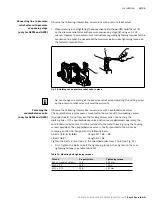
Commissioning 41/56
RE 91071-01-B/06.2018, A2FM/A2FE/A2FMT Series 70,
Bosch Rexroth AG
8.1.2 Testing the hydraulic fluid supply
The axial piston unit should always have a sufficient supply of hydraulic fluid.
For this reason, the supply of hydraulic fluid must be ensured at the start of the
commissioning process.
When you test the hydraulic fluid supply, constantly monitor noise development and
check the hydraulic fluid level in the reservoir. If the axial piston unit becomes louder
(cavitation) or the drain fluid is discharged with bubbles, this is an indication that
the axial piston unit is not being sufficiently supplied with hydraulic fluid.
For information on troubleshooting, see chapter 14 “Troubleshooting” on page 49.
To test the hydraulic fluid supply:
1.
Allow the axial piston unit to run at low speed and without load. Pay attention to
leaks and noises.
2.
Check the axial piston unit’s drain line during the test. The drain fluid should be
without bubbles.
3.
Increase the load and check whether the working pressure rises as expected.
4.
Perform a leak test to ensure that the hydraulic system is sealed and can
withstand the max. pressure.
5.
At max. working pressure, check the case drain pressure at port T
1
or T
2
. Refer to
data sheets 91071 and 91072 for the permissible value.
8.1.3 Performing a functional test
wARnInG
Improperly connected axial piston unit!
Mixing up the ports will lead to malfunctions (e.g. lift instead of lower) and
associated hazards to persons and equipment!
▶
Before the functional test, check whether the piping specified in the hydraulic
circuit diagram has been installed.
Once you have tested the hydraulic fluid supply, perform a functional test on
the machine/system. The functional test should be performed according to the
instructions of the machine/system manufacturer.
The axial piston unit is tested for functional capability and performance before
delivery according to the technical data. During commissioning, make sure the axial
piston unit was installed properly in the machine/system.
▶
After starting the drive motor, check in particular the specified pressures, e.g.
working pressure, boost pressure and case pressure.
▶
Perform a leak test without and with load prior to normal operation.
▶
If necessary, disconnect the pressure gauge and plug the ports with the specified
threaded plugs.
















































